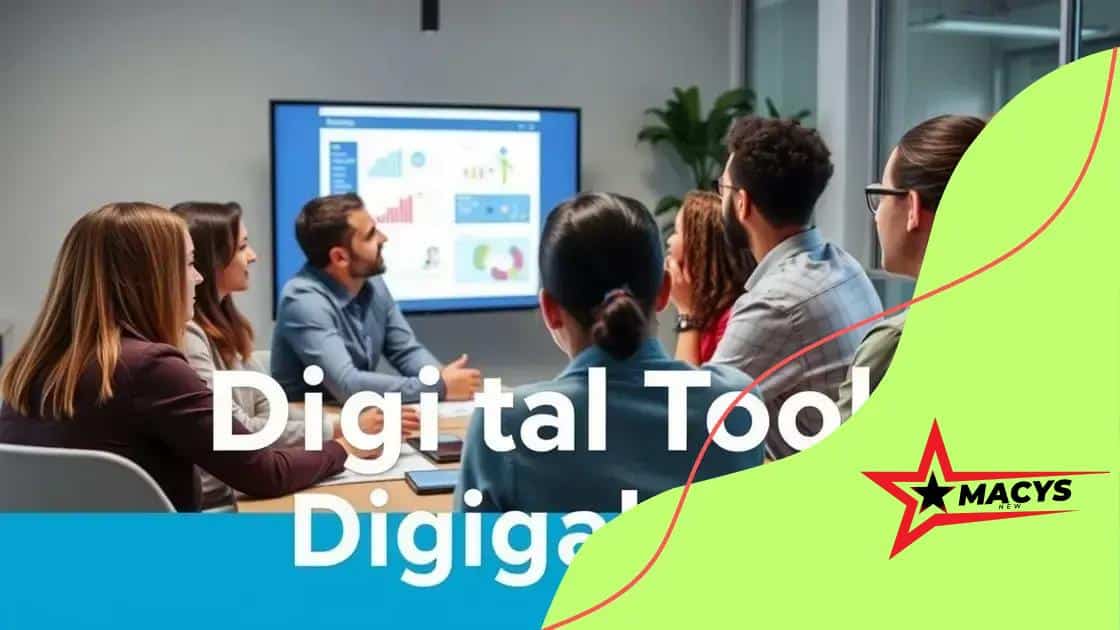Streamlining benefits enrollment with digital tools

Streamlining benefits enrollment with digital tools enhances efficiency, increases employee satisfaction through personalized options, and integrates automation and AI for a user-friendly experience.
Streamlining benefits enrollment with digital tools is becoming essential for organizations aiming to improve efficiency. Have you ever felt overwhelmed by paperwork during the enrollment season? Let’s explore how technology can simplify this process, making it smoother for everyone involved.
Understanding the enrollment process
The enrollment process can seem overwhelming, but it doesn’t have to be. By breaking it down into simple steps, you can help employees understand their options and make informed decisions. Understanding the enrollment process is crucial for a smooth experience.
Key Steps in the Enrollment Process
To streamline enrollment, consider following these steps:
- Gather essential documents: Before starting the process, make sure all necessary documents are at hand.
- Educate employees on their options: Provide clear information on benefits available to help employees choose wisely.
- Utilize technology: Online platforms can facilitate quicker submissions and decision-making.
- Set deadlines: Communicate clear timelines to ensure everyone completes their enrollment on time.
Once employees are aware of the steps, it is vital to encourage them to ask questions if anything is unclear. Establishing an open line of communication can help alleviate confusion.
Many organizations now offer digital tools that simplify the enrollment process. These tools enable employees to review their options at their own pace, reducing anxiety associated with quick decision-making. Furthermore, they can revisit their choices as needed.
The Role of Digital Tools
When discussing the enrollment process, it’s important to highlight the benefits of using technology:
- Accessible information: Employees can access benefit information anytime, anywhere.
- Automated reminders: Digital platforms can send reminders for important deadlines.
- Easy comparisons: Employees can compare different benefits side by side.
By leveraging modern technology, companies can enhance the enrollment experience significantly. Understanding how to implement these tools effectively can lead to increased employee satisfaction and engagement in the process.
Benefits of digital tools for HR
The use of digital tools in human resources has revolutionized the way organizations manage their benefits enrollment process. Benefits of digital tools for HR extend beyond simplification; they significantly improve efficiency and employee satisfaction.
Streamlining Processes
One of the main advantages of digital tools is the ability to streamline HR processes. This means that tasks which once took hours can now be completed in minutes. Digital solutions enable HR teams to automate repetitive tasks, reducing the chances of errors and speeding up the entire enrollment process.
- Automated data collection: This limits manual input, reducing errors.
- Faster approvals: Digital submissions can be reviewed and approved in real-time.
- Centralized information: All necessary files are stored in one location, making access easy.
Additionally, implementing these tools allows HR professionals to focus on strategic planning rather than administrative work. By automating routine tasks, they can dedicate more time to projects that enhance employee engagement and satisfaction.
Enhancing User Experience
Another critical aspect of digital tools is their ability to enhance the user experience for employees. When it comes to benefits enrollment, an easy-to-use platform can make a world of difference.
- Intuitive interfaces: Employees can navigate their options more easily.
- Interactive tutorials: Onboarding videos can help guide users through the process.
- Immediate updates: Employees stay informed about changes in their benefits instantly.
By creating a user-friendly environment, organizations foster a culture of transparency and support. Employees feel more empowered when they can easily understand and manage their own benefits.
Digital tools not only facilitate a quick solution for HR but also build a stronger connection between the company and its employees. Keeping staff informed and involved in their benefits supports retention and morale.
Strategies for effective implementation

Implementing digital tools for benefits enrollment requires careful planning and execution. Strategies for effective implementation can significantly enhance the likelihood of success and ensure a smooth transition.
Assess Your Needs
Before diving into the implementation phase, it’s essential to assess your organization’s specific needs. Consider factors like the size of your workforce, the complexity of your benefits offerings, and employee preferences.
- Conduct surveys to gather employee feedback on existing processes.
- Identify the most time-consuming tasks within your current system.
- Evaluate whether your existing technology can integrate with new systems.
By understanding your organization’s unique requirements, you can tailor your digital tools accordingly, leading to a more effective implementation.
Training and Support
Another critical aspect of effective implementation is providing proper training. Employees must feel confident using new systems to reap the full benefits.
- Offer workshops to familiarize employees with digital tools.
- Create tutorial videos or user manuals for reference.
- Establish a support team to answer questions during the transition.
When employees have access to adequate resources and support, they are more likely to embrace the new tools and utilize them effectively.
It’s also important to set realistic goals during the implementation phase. Start with a phased rollout, allowing teams to adapt progressively. This approach can help minimize confusion and ensure that adjustments can be made as needed.
Involving employees in the transition process creates a sense of ownership. Gather feedback and make necessary modifications based on their input. This not only improves the implementation but also fosters a culture of collaboration.
Common challenges and solutions
While implementing digital tools for benefits enrollment is beneficial, several common challenges may arise during the process. Understanding these challenges can help organizations prepare and find effective solutions.
Resistance to Change
One significant challenge is employee resistance to new systems. Many employees may feel comfortable with existing processes and hesitant to adapt to digital tools. This hesitation can slow down adoption and impact the overall effectiveness of the implementation.
- Provide information sessions to explain the benefits of new tools.
- Share success stories from other organizations to build confidence.
- Encourage feedback and address concerns during the transition.
By actively involving employees and addressing their concerns, companies can minimize resistance and promote a more positive attitude toward change.
Data Security Concerns
Another challenge involves ensuring data security and privacy. As organizations move employee data online, protecting sensitive information must remain a top priority.
- Implement strong encryption methods to safeguard data.
- Regularly update software to protect against vulnerabilities.
- Train employees on best practices for data privacy.
By taking these steps, organizations can build trust and assure employees that their information is secure.
Integration with Existing Systems can also pose difficulties. Digital tools must work seamlessly with current HR systems to function effectively. Integration issues may lead to data silos and fragmented processes.
To tackle this, it is crucial to involve IT staff during the planning stages and use reputable software that can integrate smoothly. Testing systems prior to implementation can help identify and resolve issues early on.
Future trends in benefits enrollment
As we look at the landscape of employee benefits, understanding future trends in benefits enrollment is essential for organizations aiming to stay competitive. These trends will shape how companies engage with their employees and offer valuable benefits.
Personalization of Benefits
One emerging trend is the personalization of benefits. Employees are seeking more tailored options that meet their individual needs. Organizations are starting to recognize that a one-size-fits-all approach is not effective.
- Offering flexible benefits packages allows employees to choose what works best for them.
- Using data analytics to understand employee preferences can help companies customize offerings.
- Engaging employees in the decision-making process can lead to higher satisfaction.
This shift towards personalization not only improves employee engagement but can also enhance retention rates as staff feels more valued.
Automation and AI Integration
Another significant trend is the integration of automation and artificial intelligence (AI) in the enrollment process. By leveraging technology, organizations can make the process faster and more efficient.
- Automated systems can reduce paperwork and simplify data collection.
- AI can provide employees with personalized recommendations based on their preferences.
- Chatbots can offer 24/7 assistance, answering questions and guiding employees through the enrollment process.
These advancements not only streamline the experience for HR teams but also provide employees with a more supportive environment as they navigate their benefits.
Additionally, there is a growing emphasis on mobile accessibility. As more people rely on their smartphones for daily tasks, providing mobile-friendly enrollment platforms is becoming essential.
Employees will soon expect to manage their benefits from their devices easily. This trend will push companies to invest in technology that allows seamless mobile access to benefits information.
In conclusion, the future of benefits enrollment is bright and full of potential. Organizations must embrace personalization to meet the unique needs of employees, making them feel valued and recognized. Additionally, integrating automation and AI can streamline the enrollment process, making it more efficient and user-friendly. As mobile accessibility becomes a priority, companies will need to ensure that their platforms cater to this trend. By understanding these future trends and adapting accordingly, organizations can create a benefits experience that enhances employee satisfaction and engagement.
FAQ – Frequently Asked Questions about Benefits Enrollment
What are the benefits of using digital tools for benefits enrollment?
Digital tools streamline the enrollment process, making it faster and more efficient while enhancing employee satisfaction.
How can personalization improve employee engagement?
Personalization allows employees to choose benefits that fit their needs, increasing their involvement and perceived value.
What role does AI play in the benefits enrollment process?
AI can provide personalized recommendations and automate responses, making the process more user-friendly and effective.
Why is mobile accessibility important in benefits enrollment?
Mobile accessibility ensures employees can access their benefits information anytime, anywhere, promoting convenience and engagement.





